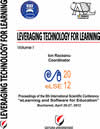PROJECTIVE TECHNIQUE – INTRODUCTORY INTERACTIVE PROJECTIVE PSYCHOLOGY SOFTWARE PRODUCED BY AN APPLIED PSYCHOLOGY DEPARTMENT. A CASE STUDY
PROJECTIVE TECHNIQUE – INTRODUCTORY INTERACTIVE PROJECTIVE PSYCHOLOGY SOFTWARE PRODUCED BY AN APPLIED PSYCHOLOGY DEPARTMENT. A CASE STUDY
Author(s): Matei GeorgescuSubject(s): Education
Published by: Carol I National Defence University Publishing House
Keywords: Projective psychology; projective techniques; stimulus-material; computer virtualprojection.
Summary/Abstract: The main projective methods are conceived to be applied in a classic-paper style and the virtual-e-learning style represents the only pre-license possible learning experience. The paper describes the experience of conceiving and using computer software in order to introduce the bases of projective psychology. The software (Matei Georgescu, Projective technique – interactive software, produced by Titu Maiorescu University, Bucharest, Romanian Copyright Office: 0113 / 06. 02. 2001) was used in the benefit of the third year students of a private university and support the direct experience with the virtual-stimulus-material of the main projective techniques such as Rotter, Düss, T.A.T., Rosenzweig, Rorschach, Szondi, Lüscher, Koch. Projective Psychology Lab was developed by the use of the computer and the Projective technique software over a semester of study. The program contains the following items: the projection concept, the analytic relation and the projective relation, verbal associative experiment, completing sentences test and fables method, Thematic Apperception Test, the frustration test, the inkblot test, the drive analysis test, the color test, the tree test, draw a person test. Each method presentation contains information about the technique, the stimulus-material and the manner of interpretation. The access to stimulus-material of the Thematic Apperception Test, the frustration test, the inkblot test and the drive test analysis is possible in the order of test protocol. The software allows the color calibration of Lüscher test and also quotation examples. The Rorschach stimulus-material can be rotated within 360 degrees limit. The quotations index of the tree test is accessible in the order of the main interpretative zones. Despite the fact that the projective techniques were not conceived to be applied in the virtual-computerized style, during the three years pedagogical experiences with the Projective technique – interactive software, we have noticed the success of such an introductory way of learning.
Journal: Conference proceedings of »eLearning and Software for Education« (eLSE)
- Issue Year: 8/2012
- Issue No: 01
- Page Range: 161-166
- Page Count: 6
- Language: English

